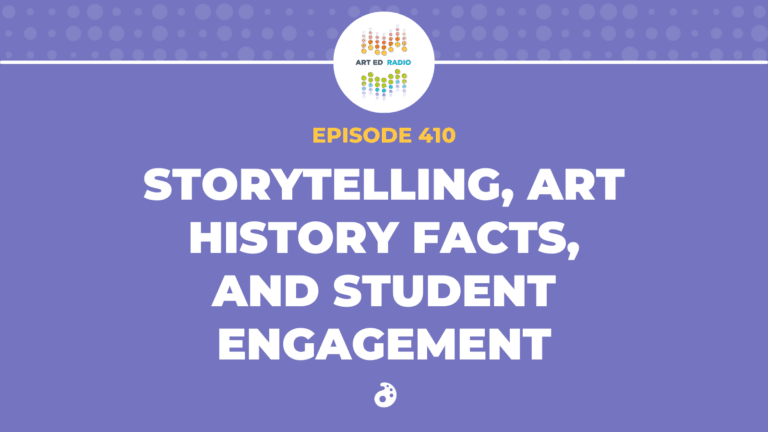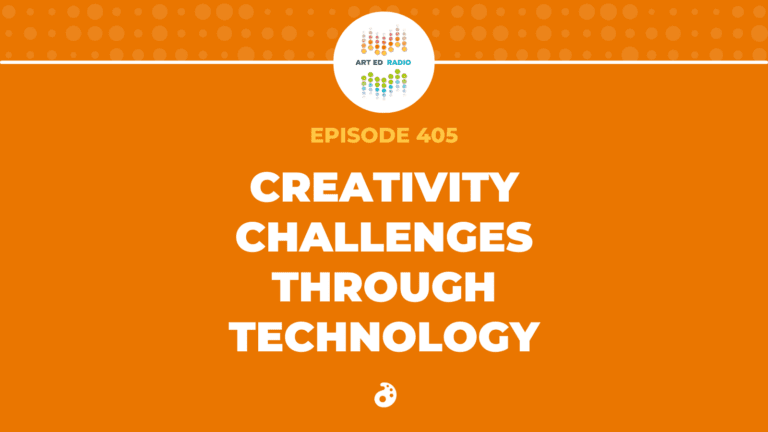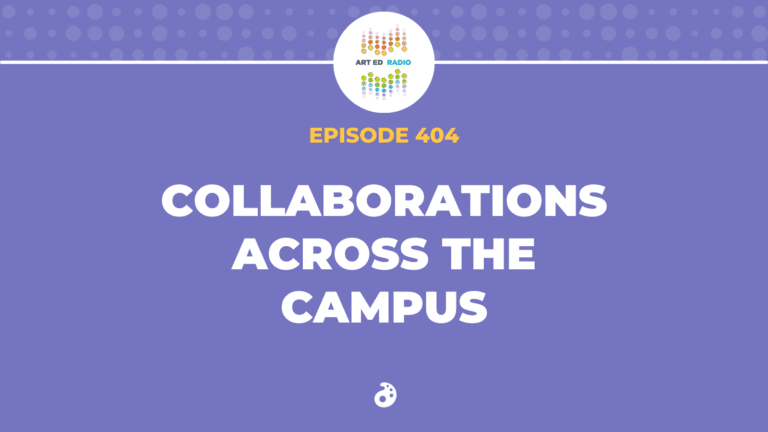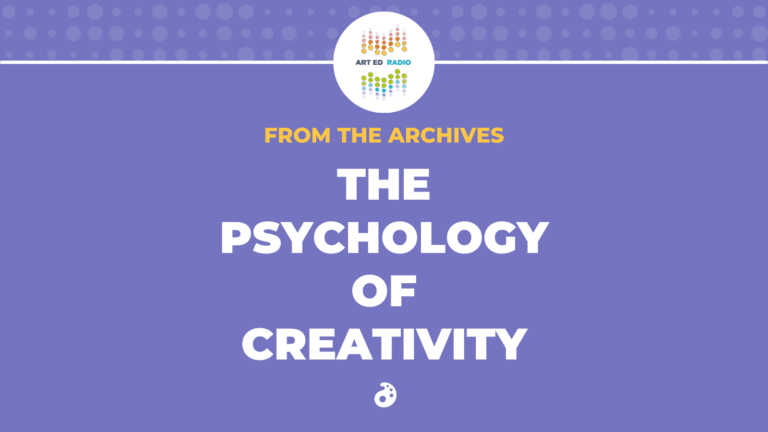Though it has been a while since many of us have traveled, the opportunity is coming back on the horizon for many. Art educator Mercedes Faunde joins Tim today to share some of her favorite stories from a career full of teaching and travel. Listen as she talks about why she loves seeing artwork in person, how travel continues to inform her teaching, and the opportunities available for teachers who want to use travel to enhance their curriculum. Full Episode Transcript Below.
Resources and Links
- National Consortium for Teaching About Asia
- Fulbright Grants for Teachers
- National Endowment for the Humanities
- Uberoi Foundation for Religious Studies
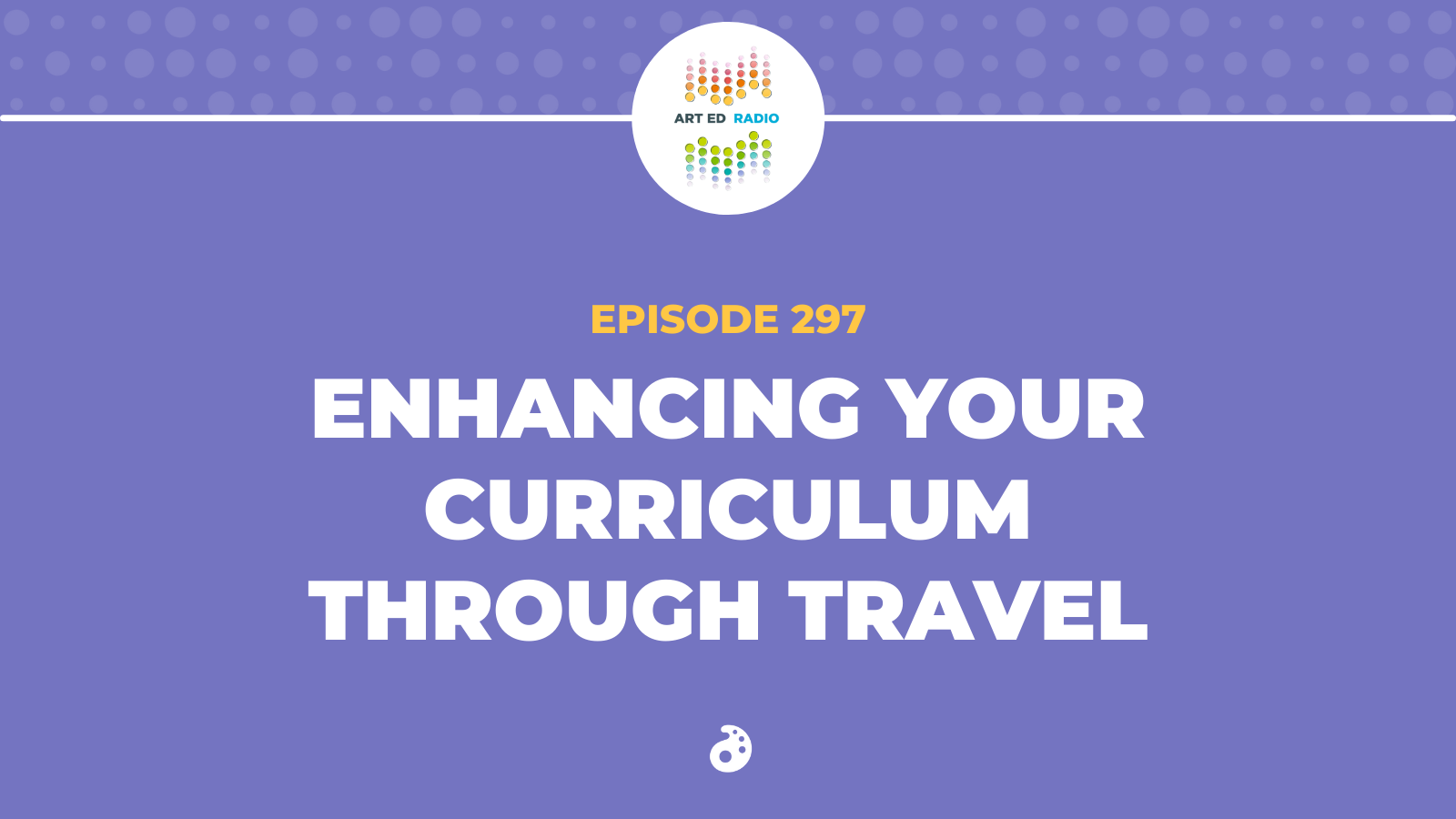
Transcript
Tim: Welcome to Art Ed Radio, the podcast for art teachers. This show is produced by the Art of Education University, and I’m your host, Tim Bogatz.
We are going to talk today about travel, which is kind of a weird thing right now, I know. Because so many of us have been stuck in one place for so long, but I think there can be a lot of value in travel. I think there can be a lot of value in the discussion of it. So I am looking forward to the conversation today. My guest is going to be Mercedes Faunde. I first connected with Mercedes online at the NAEA Conference last year. I absolutely love talking to her, just her stories and her experiences are wonderful to listen to.
So I hope the conversation is worthwhile for you today. If you do enjoy it, Mercedes is also going to be part of the NOW Conference in February of next year. So just a couple months away. We can talk more about that at the end of the episode, but I am excited to chat with her today. Because Mercedes does an amazing job turning what she has done and seen into lessons and conversation, and connections with her students. I’m hoping we get to hear all about that today. So let me welcome her on now. Mercedes is joining me now. Mercedes, thank you. How are you?
Mercedes: I’m good, Tim. How are you?
Tim: I am great. We have a lot of cool stuff to talk about. Before we get into travel and teaching and all of that great stuff, can you do just start out with an introduction? Can you tell us a little bit about yourself, about your teaching and maybe some interests outside of the classroom?
Mercedes: Sure. So I have been an art educator at the same school for 30 years. I can’t believe it. It’s a wonderful school in Bergen County, New Jersey, north of New York City. It’s incredible how time just goes by. So throughout those 30 years, I’ve taught middle school, high school, and as you can imagine, everything. From fine arts to digital arts to photography, whatever they needed, that’s what I taught. So it gives you a lot of great experience. I’ve also worked for museums. I started my career at the Metropolitan Museum of Art in their outreach office. So that was really cool. Outreach was part of education, and I had an opportunity to travel to all five boroughs of New York city and present different exhibits. The whole goal was to attract more visitors to the museum. Then, most recently I was a teacher in residence for the Smithsonian Museum Freer and Sackler galleries. I was part of a group, they’re working on a new teacher’s portal on teaching Asian art, which will be coming out next year. So that’s going to be really cool and that was a really fun experience.
Tim: Yeah, and kind of your area of expertise too, right?
Mercedes: Well, it’s funny, it’s kind of like become my area. I really don’t think of myself as an expert, but I love it right now and I love learning about it, and I was able to travel to Asia. So yeah, I guess so.
Tim: All right. That’s cool. Now, I guess we should and talk about how we first connected, I saw you present at the digital NAEA Conference earlier this year. You were talking, presenting on how your travels impacted your teaching. So can you talk more about that, just why you love to travel? Why that’s so important to you?
Mercedes: Sure. So I’ve always loved to travel. My first big trip abroad was in college. I did a study abroad. I went to England, and that was probably the best decision I made as an undergraduate. So if anyone out there have children who are currently in college and they’re asking you, should I do this? Absolutely yes. It’s an amazing experience. So personally, professionally, I have a huge curiosity to learn. Even at this stage in my career, I really love that. The more I know, the more I see that there’s so much more to learn. I can share with you, I was thinking about it this morning, a really quick anecdote. So in 2019, I had the opportunity to travel to South Korea with a group of art teachers through The National Consortium for Teaching about Asia, which by the way is a wonderful group.
We were in a palace in Seoul, and we’re looking at the architecture and we’re looking at the roofs, and we’re noticing how the very classical roofs that turn upward and then there were these animal figures on the roof. Our guide was explaining to us that it was Sun Wookong, the Monkey King from the classic story Journey to the West. Everyone in my group was nodding their heads like, “Oh yes. Yes, of course, that’s Sun Wukong.” I’m thinking, “Oh my God, I don’t know who that is. This is someone I need to learn about because everybody here obviously knows this.” So I love those moments. I love those moments where I think I have a good body of knowledge about a subject, and then all of a sudden I’m presented with something new and exciting.
So I love to experience art firsthand. I love talking to people. I love to be on the ground. That’s what I really crave, to be in the markets, to talk to the people there. It really brings a lot of authenticity to my teaching and later helps me connect with students. So that’s what I love.
Tim: Okay. That’s awesome. That actually brings me to the next point, talking about authenticity in your teaching, making those connections. Can you talk more about how you make those connections? How you bring those ideas into your classroom? How do you bring the experiences, the ideas from your travel into your classroom, into your teaching?
Mercedes: Sure. So I teach formally through lessons. I’ll bring in those connections and also informally, I try to do both. The informal part comes from photos, stories, just yesterday, a student in class, who knows that I went to South Korea. She asked me, “Oh, are you familiar with this Korean snack?” and she told me the name and I said, “No. Actually, but when I was in South Korea, I loved the Korean Honey Butter potato chips,” and she said, “Oh yes, yes, those are fabulous.” Then, another student said, “Oh, I’ve tried those. They sell them in the local Korean market.” So I love those moments. Those are the real fun moments. But formally, I’ll go back to that. So what I try to express to my students, especially when teaching art history, which I have done from the very beginning is, there’s different levels in teaching and understanding art history.
The first one is the most accessible, right? So that’s anything in a reproduction form. So that could be through print, online images, posters, in a book. Those are your first encounters with a work of art, which is wonderful. That’s like a gateway into it. Then, the next best thing is to actually go to a museum or gallery and see the work of art in person, especially when you’re looking at sculpture, to actually walk around the sculpture. Look at scale, see any texture qualities that it might have. That’s level number two, which is also very good. But then I tell them, the best way to really experience a work of art is what is called in C2, which you know, Tim. That for me, this is what I absolutely love, to go to the location where the artwork was either created or where it was meant to be seen.
So I can give you two examples of when I had this experience with students, and then personally, when I had it with teachers. So I have led trips with students abroad to Europe and South America. For one particular trip, when we were preparing to go to France, we were talking about Monet and Monet’s Garden. We had planned a trip to Giverny, his garden outside of Paris. So I led the students through first looking at reproductions of Monet’s Water Lilies. Then we had the opportunity to go to the Metropolitan Museum of Art and look at his paintings in the galleries, which was very cool, because they could see the colors, they could see the size. Then, once we got out to the garden and we saw his inspiration, it was like magic. They were, and I know magic is happening when they’re absolutely quiet, and they’re just looking and they’re taking it all in.
Of course, the guides are wonderful and the guides explain things really great, but they get it. That’s the really wonderful moment. Then, just briefly for me personally, we’re all familiar with Leonardo’s Last Supper. We’re familiar with this painting. It’s everywhere. It’s ubiquitous. I had the opportunity with students to go to Milan. We were able to get tickets to the chapel where the painting, the fresco is on the wall and that was incredible. You see the size. Leonardo was so brilliant. It was in a dining room where he painted it and the way that the sunlight came on the painting. He worked with all of this and you can still see it today.
Then lastly, this was such a surprise, when I was in Jerusalem with a Fulbright grant with other teachers, we went to the room in Jerusalem where Jesus had the last supper and I was blown away. I’m like, it’s a small room. It’s above King David’s tomb in Jerusalem, and the guide was like, “Oh, by the way, this is where they think that Jesus had the last supper,” I was like, “This is unbelievable.” Those memories that’s just stay with you for the rest of your life.
Tim: Oh yeah. Those are absolutely incredible experience that I love hearing about, about all of those. So let me ask you though. I know teachers love to hear about specific lessons, like the way you’re using these things in your teaching. So could you give us a specific example of a lesson or a couple of lessons that have kind of been inspired by your travels?
Mercedes: Sure. I was thinking about this, and I came up with a pretty long list because I really tried to infuse everything, not only my experiences, but of course I bring back artifacts, right? From the different countries and how I share this. So I’ll just share two. I really loved when I was teaching crafts to teach about ancient mosaics.
Tim: Oh yeah.
Mercedes: I would bring pictures of all the Roman mosaics that I’ve seen throughout Europe, because you know the Roman Empire was vast and what they left behind. Sometimes it’s so interesting, you may find the best sculpture and the best architecture from the Roman Empire outside of Rome. So I’d that lesson, and then also again, when I was in Israel, I had an opportunity to look at mosaics inside of a very old synagogue and then also a Muslim mosque. So that was really cool, bringing that all together. But one particular lesson that I’ll go more in detail of is, again, when I was teaching ceramics and crafts. I talked about the influence of Chinese blue and white pottery, and how this one art form really rocked the known world.
Through the silk road, how the Chinese exported the blue and white porcelain and how it influenced different cultures throughout the centuries. So I have a little reproduction of a Ming dynasty vase. I’ve never been to China. That’s on my list. So I show them an example and they pass it around and look at it. Then, I have a map, and this is so important, I have always had a map of the world in my classroom. As I’m explaining different countries, because children need reinforcement of geography always, and why not in an art classroom? Because then it’s in context. So hopefully they’ll remember. Okay. So then moving along from China along the silk road, we go to Turkey. I talk to them when I went to Ephesus and I bought a coffee mug and it has a beautiful Iznic blue and white pottery on it, a design. We pass that around.
From Turkey, I talk about the influence of the pottery in the Mediterranean, specifically Sicily and the island of Majorca right outside of Spain. From Sicily, I show them a wonderful painted ceramic container with wonderful lemons. But then, the one from Majorca is really, really cool. In Majorca, I went to this monastery, right, from the 17th century. There is an apothecary in this monastery that, Tim, it looks like when you walk in there, you are going back into the 17th century. There is wall of ceramic jars. All full of cobwebs and dusty, and possibly inside are still the different potions that were created there. It is the coolest, coolest apothecary. The reason we went there is Siobhan lived there for a while, and he had a suite of apartments.
As I’m walking there, oh, and it was so funny because my son, he’s really my museum buddy. He’s in college now, and he told me this morning, mom, don’t talk about me. But I do have to mention this, while we’re walking to this monastery, he’s singing like a chant from the monks.
Tim: Yep.
Mercedes: He’s like, this is the coolest place. Anyway, they had reproductions. So I brought back a blue and white jar, and it’s all relating back to the Chinese porcelain. Then, after I showed them that, we also had the opportunity when I traveled with students to go to the Netherlands. We went to the Delft factory where they have produced Delftware for hundreds of years. I show them that, I have a special tulip phase, and then we finish in England with British bone China, specifically Spode. So when I taught this lesson, I absolutely loved it because I could show them real objects and they could see the connection of how this pottery, which to teenagers may not be so special. But when they see how it influence so many cultures, I think it’s really cool.
Tim: Yeah. I think that is really cool. Awesome. So I want to ask you, you’ve mentioned a couple times now traveling with students, France and Italy, Netherlands here. Can you just talk about the experience of traveling with students and I guess the big difference? What is the big difference between traveling with students and traveling by yourself?
Mercedes: Sure. So between 2012 and 2018, I did seven trips with students through different countries in Europe and South America. I connected with our foreign language teachers on some of the trips and some of them, I led my myself. So they were just amazing, amazing experiences. I’m thinking back to really special moments. There were moments where students were so overtaken by the beauty of what they saw, that they started to cry and that’s what beauty does, right? Those were true, authentic, aesthetic experiences. They were all happy tears and they were so overtaken in their young lives of what they were seeing. One really special story that I want to share is what happened to a wonderful student, his name is Charlie. He went on to study at the Art Institute of Chicago. We were in Avignon, in the south of France and we were all back on the bus.
During lunchtime they typically had free time. They could go off in small groups and have lunch, and experience things on their own. So we’re all back on the bus, we’re waiting, we’re waiting and Charlie’s not on the bus. So of course this is the time where teachers were like, “Where’s Charlie?” Charlie is a wonderful boy, right, he’s super responsible. Charlie by the way was and is a wonderful photographer. So I’m thinking, Charlie’s probably taking pictures somewhere, lost track of time. Charlie finally gets on the bus and he’s like, “Oh my God, you will not believe what just happened to me,” and then I asked, “All good. Right?” Good stuff,” and he’s like, “Yes, yes, yes. All good. All good.” I’m like, “Okay. Okay. What happened?” So of course the bus becomes silent and everybody’s listening to Charlie.
He said, “So after lunch, I’m sitting in the square in Avignon,” which by the way is just the most beautiful square with beautiful fountain, cafes all around. He said, “I finished my lunch. So I’m sitting there,” and Charlie was such a wonderful kid. He really worked hard. He saved this money. He bought all this special camera equipment to take on the trip and he had it all with him, right? So he’s sitting there with his camera equipment, soaking it all in. This gentleman comes up to him, speaks to him in English and says, “Hey, are you a photographer?” He says, “Yes, by the way I am,” and he is like, “Oh, I notice such and such camera equipment,” right? They start to talk the language of photographers like, I notice your camera, your lens, all of that.
He says, “I’m a photographer as well. Do you mind sharing with me some of your photographs?” Charlie said, “Sure,” of course, kids nowadays have their whole portfolios on their phones. Shows them the pictures. He says, “Wow. That’s really, really wonderful stuff. I am a photographer in New York City. I have a gallery. Would you like coming and working for me as an intern?”
Tim: Oh my God.
Mercedes: I know. Isn’t that incredible? Charlie says, “Oh my God, yes, and I live in New Jersey. So that would not be a problem at all,” and he’s like, “Great. Here’s my business card. Call me when you get back home. Great meeting you,” and that was Charlie’s great story.
Tim: Wow. Incredible.
Mercedes: He shared that with everybody on the bus. We all cheered for him. Yay. Charlie got an internship. That was a really big highlight. That’s a story I will always remember.
Tim: Oh yeah. That is fantastic. So I guess last question for you too, obviously COVID has put a pause on everything travel related, both for you, for your students, for everybody who’s wanting to travel. So have you started making plans post-COVID? Do you know when you’re going to be traveling again? Do you think you’re going to be taking students anywhere anytime soon?
Mercedes: Well, you had asked me before, of course, I’m itching to travel again.
Tim: Right.
Mercedes: Yeah. Of course, I’m already telling my husband, we’ve got to make plans for next year. Also personally, my husband’s from the Basque Country and because of COVID, we haven’t seen his parents, his family. So we’re really wanting to do that again. But you had asked me before, Tim, and I neglected to answer the difference between traveling with students and traveling by yourself or traveling with teachers. The biggest thing is the huge responsibility that comes with taking young people, students abroad. It is wonderful, but it is a huge responsibility. So if anyone out there is considering doing it, I was for many years, I thought maybe this is something I’d like to do. The biggest thing I recommend is if someone at your school is already doing these type of trips, go as a chaperone, see what it’s like without having the full responsibility of being the lead teacher, and then you can really see if it’s for you.
So I don’t know right now, I don’t know if I’ll take students again. The pandemic has really thrown a whole different obstacle. I think I want to make sure that the whole world has been vaccinated or at least we’ve got this pandemic under control before I do that again.
Tim: Yeah. That makes sense.
Mercedes: Another thing that I’ve mentioned, I’ve mentioned Fulbright, I mentioned NCTA, the National Consortium for Teaching about Asia. If there are teachers out there that are thinking, maybe I want to travel with other teachers, which by the way is so much fun to travel with other adults, because you’re just responsible for yourself, that’s it. You’re not responsible for anyone else, and you can have fun and you can be with colleagues and you can learn so much from other colleagues. So Fulbright is a wonderful organization. Many people are familiar with it. It is very competitive, and what I can recommend to other teachers, if you’re thinking of applying to Fulbright, do some lessons first on the countries that you wish to visit.
When I applied, I had already had some experience teaching lessons. So they see that you have a genuine interest in learning more about a particular country or culture. So Fulbright’s great. The National Endowment for the Humanities also has a lot of opportunities for teachers. I was awarded a grant to study Islamic art. That was wonderful. Most recently, the Uberoi Foundation for Religious Studies is also a great organization. This past year I received a fellowship. It was all virtual, but it was still wonderful on Indian religions and I learned a whole bunch on that. Then, the last one is, I mentioned the Smithsonian teaching Asian religion site, which is going to come out later this year, which is going to be a really wonderful resource for teachers.
Tim: Yeah. That’s awesome, and we will put links in the show notes to as many of those as we can.
Mercedes: Great.
Tim: If people want to check those out. Mercedes, thank you so much. We appreciate the recommendations. We appreciate the advice, and I think everybody just enjoys hearing the stories. Thank you for taking the time to chat with us.
Mercedes: Thanks for the invitation, Tim.
Tim: All right. I hope you enjoy that conversation. Now, earlier I mentioned the NOW Conference. You hear me talk a lot about that. We do it twice a year, once in February, once in July. We have a lot of amazing presentations coming this time around, one from Mercedes who we just talked to on the importance of incorporating Asian art in your curriculum. You’ll hear a lot more about the conference in the coming weeks, but it will be happening on February 5th, not too long after the New Year. As always, it’ll be a great day of PD with art teachers from all over the country, honestly, all over the world and everything is designed for art teachers. If this is something that interests you, you can learn more by visiting the AOEU website and clicking on the NOW Conference tab. Now, one other thing, before we go, we are going to be doing a podcast or two or three, depending on how it goes on what new teachers are missing out on and what new teachers need to know.
If you are a new teacher who has questions or needs advice, please email me, timothybogatz@theartofeducation.edu or DM me on Twitter. I’m @TimBogatz there. If you are an experienced teacher who wants to share some advice, we would love to hear that too, whether it be classroom management or curriculum or advocacy or anything else, reach out with that too. I want to hear from everyone, whether you are new, whether you are experienced, whether you’re in between. I’m really looking forward to some of these upcoming episodes. But thank you so much to Mercedes for coming on today. Whether travel is going to be coming up for you, whether it’s for your own personal enjoyment or something educational, like I said, at the beginning, it can be incredibly worthwhile. If you are going to be doing some travel, either something local or something much, much further away, think about how you can make art a part of your plans.
Art Ed Radio is produced by The Art of Education University with audio engineering from Michael Crocker. Thank you for listening and we’ll talk to you again next week.
Magazine articles and podcasts are opinions of professional education contributors and do not necessarily represent the position of the Art of Education University (AOEU) or its academic offerings. Contributors use terms in the way they are most often talked about in the scope of their educational experiences.
